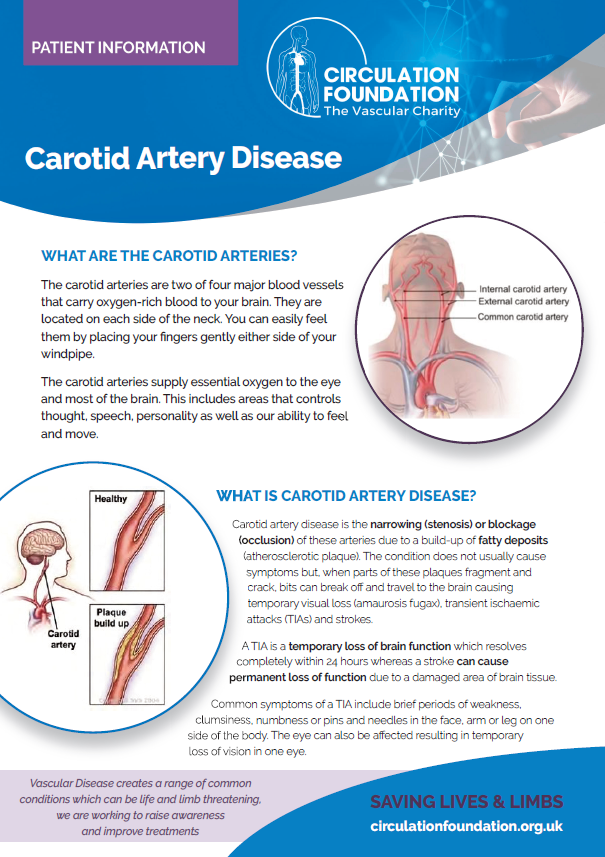Carotid Artery Disease
|
Whilst we make every effort to ensure that the information contained in this patient information sheet is accurate, it is not a substitute for medical advice or treatment. The Circulation Foundation recommends consultation with your doctor or health care professional. The information provided is intended to support patients, not provide personal medical advice. The Circulation Foundation cannot accept liability for any loss or damage resulting from any inaccuracy in this information or third-party information, such as information on websites to which we link.
|

Click here to download
|
What are the carotid arteries?
The carotid arteries are two of four major blood vessels that carry oxygen-rich blood to your brain. They are located on each side of the neck. You can easily feel them by placing your fingers gently either side of your windpipe. The carotid arteries supply essential oxygen to the eye and most of the brain. This includes areas that control thought, speech, personality, as well as our ability to feel and move.
What is carotid artery disease?
Carotid artery disease is the narrowing (stenosis) or blockage (occlusion) of these arteries due to a build-up of fatty deposits (atherosclerotic plaque). The condition does not usually cause symptoms but, when parts of these plaques fragment and crack, bits can break off and travel to the brain, causing temporary visual loss (amaurosis fugax), transient ischaemic attacks (TIAs), and strokes.
A TIA is a temporary loss of brain function that resolves completely within 24 hours, whereas a stroke can cause permanent loss of function due to damaged brain tissue. Common symptoms of a TIA include brief periods of weakness, clumsiness, numbness, or pins and needles in the face, arm, or leg on one side of the body. The eye can also be affected, resulting in temporary loss of vision in one eye. People who have TIAs may be at high risk of having a stroke within the next few days.
Some people recover completely from strokes or may be left with only minor problems, but many people have serious life-long disabilities. These can include speech difficulties, paralysis, and/or an inability to care for themselves.
What causes carotid artery disease?
Most people have some fatty deposition in their arteries. For most, these cause no problems.
Several factors influence the chances of having severe carotid artery disease. It is more common in men, in those with a close family member who has had atherosclerotic vascular disease (such as stroke or heart disease), and it becomes more common with increased age. Other factors that can be modified or optimized include smoking, high cholesterol, high blood pressure, and/or diabetes.
If you already have symptoms from narrowed arteries in the legs or heart disease, you may be at higher risk of carotid artery disease and stroke.
How is the diagnosis made?
The narrowing in the carotid arteries can be seen with an ultrasound scan of the arteries in the neck (duplex) or sometimes with a CT or MRI scan.
How is it treated?
Lifestyle changes:
Stroke risk can be reduced by:
- Stopping smoking
- Eating a diet rich in fruits, vegetables, and oily fish (omega-3) and low in meats, sweets, and refined grains (such as white bread or white rice)
- Eating less salt (sodium)
- Doing something active for at least 30 minutes a day on most days of the week and trying to lose weight
- Limiting the amount of alcohol you drink
Medicines:
Some medicines will also reduce the chances of having a stroke. These include:
- Medicines for blood pressure control
- Statins: drugs that lower cholesterol and reduce the chance of atherosclerotic plaques cracking or fragmenting
- Medicines to make the blood less sticky and reduce the chance of it clotting, such as aspirin and/or clopidogrel
Surgery:
An operation called “carotid endarterectomy” is advised for people who have had a TIA or stroke with a lot of plaque in their carotid arteries. It can also be appropriate for some people to have this operation with large amounts of plaque but who have not yet had a stroke or TIA, as they are at increased long-term stroke risk.
Carotid stenting:
If this is recommended, doctors will insert a tiny metal tube called a “stent” into the carotid artery. This is designed to keep narrowed arteries open. This treatment is an alternative to surgery, with ongoing studies evaluating which is better for particular patients.
Which treatment is right for me?
The right treatment will depend on:
- Whether you have already had a stroke or TIA that seems to be caused by your carotid artery disease
- How much of your carotid artery is narrowed by plaque
- Whether you have other important health problems besides carotid artery disease
If your doctor suggests surgery or stenting, you may wish to ask these questions:
- What are the chances that I will have a stroke if I do not have this procedure?
- What are the chances that I will have a stroke if I do have this procedure?
- What are the risks of the procedure?
Whether or not you need one of these treatments, you must stop smoking completely to significantly reduce your risk of future stroke, heart disease, and peripheral vascular disease (narrowing of the arteries in the legs and abdomen).